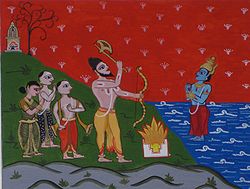Tulu Nadu
Tulu Nadu, also called as Tulunaad, is a region on the southwestern coast of India.[4] The Tulu people, known as 'Tuluva' (plural 'Tuluver'), speakers of Tulu, a Dravidian language, are the preponderant ethnic group of this region.[5] South Canara, an erstwhile district and a historical area, encompassing the undivided territory of the contemporary Udupi, Dakshina Kannada, and Kasaragod districts, forms the cultural area of the Tuluver.[6]
Region | |
| Coordinates: 13°00′N 75°24′E / 13.00°N 75.40°ECoordinates: 13°00′N 75°24′E / 13.00°N 75.40°E | |
| Country | |
| State | Karnataka, Kerala |
| Districts | Dakshina Kannada, Udupi, and Kasaragod |
| Founded by | Parashurama |
| Largest City | Mangalore |
| No. of districts & Talukas | 3 District and 18 Taluks |
| Area | |
| • Total | 10,432 km2 (4,028 sq mi) |
| Population (2001)[3] | |
| • Total | 3,957,071 |
| • Density | 356.1/km2 (922/sq mi) |
| Languages | |
| • Official | Kannada, Malayalam |
| • Spoken | Tulu, Kundagannada, Konkani, Beary, Arebhashe |
| Time zone | UTC+5:30 (IST) |
| ISO 3166 code | ISO 3166-2:IN |
| Vehicle registration | KA19, KA20, KA21, KA62, KA70, KL14. |
Historically, Tulu Nadu lay between the Gangavali River (Uttara Kannada district) in the north and the Chandragiri River (Kasaragod taluka) in the south.[7] Currently, Tulu Nadu consists of the Udupi and Dakshina Kannada districts of Karnataka, and the northern parts of the Kasaragod district of Kerala up to the Chandragiri River.[8]
This region is not an official administrative entity.[9] However, the Tulu Nadu state movement has been gaining momentum since the Indian States Reorganisation Act, 1956.[10]
Mangalore, the second largest and a major city of Karnataka, is the chief and largest city of Tulu Nadu.[11] Udupi, Kasaragod and Puttur are the other major cities of this region.[12]
References
- ↑ "Tourism in DK District". National Informatics Centre, Karnataka State Unit. Archived from the original on 19 September 2008. Retrieved 26 March 2008.
- ↑ "Tour to Udupi". Tourism of India. Retrieved 26 March 2008.
- ↑ "Census GIS India". Census of India. Archived from the original on 11 January 2010. Retrieved 26 March 2008.
- ↑ Anthropological Survey of India (Department of Anthropology) (1980). Bulletin of the Anthropological Survey of India, Volume 25. Director, Anthropological Survey of India, Indian Museum. p. 41.
- ↑ Minahan, James B. (2012). "Tuluvas". Ethnic Groups of South Asia and the Pacific: An Encyclopedia: An Encyclopedia. Ethnic Groups of the World (illustrated ed.). ABC-CLIO. ISBN 9781598846607.
- ↑ Bhat, N. Shyam (1998). "Introduction". South Kanara, 1799–1860: A Study in Colonial Administration and Regional Response. Mittal Publications. pp. 1–16. ISBN 9788170995869.
- ↑ Bhatt, P. Gururaja (1969). Antiquities of South Kanara. Prabhakara Press. p. 2.
- ↑ "Tulu Nadu Region". keralatourism.org. Government of Kerala. Retrieved 15 September 2018.
- ↑ Unnithan, Rajmohan (7 January 2020). "A case for including Tulu in the Eighth Schedule". The Hindu. https://www.thehindu.com/opinion/op-ed/a-case-for-including-tulu-in-the-eighth-schedule/article30496165.ece/amp/. Retrieved 15 January 2020.
- ↑ B, Sreekantswamy (21 July 2017). "With separate 'flag,' Tulu activists up demand for statehood". Deccan Herald. https://www.deccanherald.com/amp/content/623813/with-separate-flag-tulu-activists.html. Retrieved 15 January 2020.
- ↑ Sheth, Anisha (6 November 2014). "This city has six names in six languages, and the official one Mangaluru, is the least popular". The News Minute. https://www.thenewsminute.com/karnatakas/326. Retrieved 15 January 2020.
- ↑
Tulu Nadu Media
As per Hindu mythology, Parashurama commanded Lord Varuna to make the seas recede to make the Tulu Nadu.
Tulu script has been used for Tulu since at least the 10th century.
A Yakshagana artist portraying a rakshasa (demon).
A typical house in Tulu Nadu, with the roof constructed using Mangalore tiles
- Flag of Tulunadu.jpg
Cultural flag of Tulunadu region in India
Malli, Karthik (28 February 2019). "Mapping Tulu: A rich oral tradition with deep roots in Karnataka". The News Minute. https://www.thenewsminute.com/article/mapping-tulu-rich-oral-tradition-deep-roots-karnataka-97512. Retrieved 15 January 2020. "Tulu is a southern Dravidian language that's spoken by 1.85 million people in Dakshina Kannada, Udupi and Kerala's Kasargod district.".








